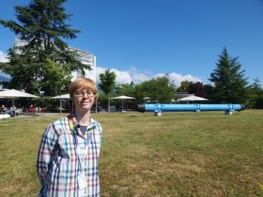Frank Reed is the creator of the Centennia Historical Atlas software, which provides a cartographic guide to the history of Europe and the Middle East from AD 1000 to the present day

Why did you choose to study physics?
Being a child of the Moon-landing era, I was always interested in astronomy and space science. I eventually came to understand that physics was the power behind all the interesting things in the physical sciences, so I decided to study the subject at Wesleyan University in Connecticut in the US. I specialized in gravitational physics and wrote a thesis on the quantum behaviour of hydrogen atoms in the highly curved space–time near small black holes. I enjoyed it immensely, and my only regret is that there was not a better career path open to me afterwards.
What did you do after you left university?
I graduated with a BA in physics in 1984, after which I taught physics at an elite secondary school in New York City for three years. After that, I got into options trading and pricing models, which are actually rather closely related to some of the maths that appears in physics.
How did you come to create the atlas?
I got the idea for the Centennia Historical Atlas in the summer of 1990 when the Cold War ended. At that time the map of Europe was changing after decades of stability, and I thought I could make some money by putting those changes into a historical perspective — and that’s how I’ve been making my living ever since.
Can you explain what the atlas is all about?
It is a dynamic atlas of Europe and the Middle East from the year AD 1000 to the present day that puts 1000 years of history and 10,000 maps on a history student’s computer. When the software launches, the student has a map in front of them that can be played forwards or backwards in time. Countries and empires come and go right before your eyes.
How successful has it been?
After its initial release in the early 1990s, the atlas was immediately adopted by the US Naval Academy for their introductory course in Western civilization. By now, over 18,000 students at the Naval Academy, many of whom as now officers in the US Navy, have studied history using it. The atlas is also popular with diplomats and others connected with international relations — for example, I have one former director of the CIA and one former US secretary of state on my customer list. The atlas is also required reading at many universities across the world, and it is a popular tool among history enthusiasts and genealogists.
What are you working on at the moment?
As well as constantly making incremental improvements to the current edition (a free version is available for download at www.historicalatlas.com), I’m extending the atlas to cover the history of North America from the pre-Columbian period forward. I’m also working on software projects connected with celestial navigation and nautical astronomy. For example, I’ve developed tools that predict the exact position of the Moon and analyse lunar distance sights, which will allow modern navigation enthusiasts to determine their “longitude by lunar distances”, which was once the epitome of the navigator’s art. I also occasionally write options-pricing software for the financial markets.
Does your physics degree help you in your current work?
Though the contribution was minor and basically metaphorical, my physics education perhaps made it a bit easier to envision time as the fourth dimension for a map of history. It does help significantly with the work that I do on nautical astronomy, however. For example, I recently ran some numerical integrations to create refraction tables for variable atmospheric conditions. Also, in options-pricing models, the pricing is essentially identical to the mathematics of diffusion in physics.
Do you still keep up with physics at all?
I take every chance I get. Of course, it’s impossible to keep up with all of physics, but I try to keep up with the latest developments in gravitational physics, both in terms of the practical application of gravimetry and the higher level of developments in general relativity. I manage an online list related to nautical astronomy and celestial navigation, and every now and then I end up talking about gravitational physics. Just recently I managed to get a few people interested in the local tidal field of the Earth by segueing from a discussion of inertial navigation.



